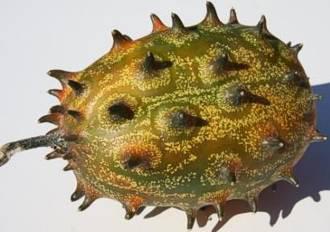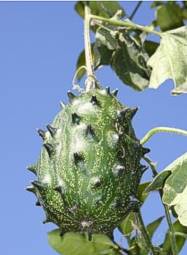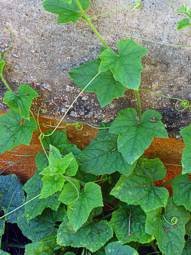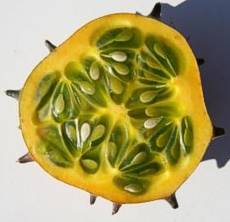Cucumis metuliferus
Cucumis metuliferus E.Mey. ex Naudin
Family: Cucurbitaceae
Common names: African horned cucumber, jelly melon, kiwano (Eng.); rooi-agurkie, rooikomkommer (Afr.); mokapana (Tswana)
Introduction
This African climber is cultivated in various parts of the world for its showy, edible fruits.

Description
Description
Cucumis metuliferus is an annual climbing or rarely trailing herb; vegetative parts rough with spreading hairs. Stems are up to 3 m long, radiating from a woody rootstock. The leaves are broadly ovate-cordate in outline, up to 90 x 100 mm, unlobed or usually palmately 3-5-lobed, veins below very roughly hairy, margins minutely toothed; leaf stalks (petioles) up to 100 mm long. Both male and female flowers appear on the same plant (monoecious). Male flowers are solitary or up to 4 in sessile or short-stalked groups, greenish to light yellow, the corolla is 5-10 mm long. Female flowers are solitary on 20-60 mm long stalks; the ovary is up to 20 mm long, pale green with numerous minute, dark green fleshy spines, the corolla is yellow, 8-15 mm long. The fruit is ellipsoid-cylindrical, obscurely trigonous (triangular in shape), 60-150 mm long, 30-60 mm across when ripe, the scattered spines are rather stout, fleshy, ± 10 x 2-5 mm, broad-based, deep green-grey, ripening yellow to orange-red with obscure longitudinal stripes of small pale markings and rather softly fleshy. Seeds are ellipsoid, flattened, 6-9 mm long, numerous, embedded in a light green or emerald-green, jelly-like flesh.


Distribution and habitat
Distribution description
Cucumis metuliferus grows naturally in tropical Africa south of the Sahara down to Namibia, Botswana, South Africa and Swaziland. In South Africa it is found in Limpopo, Mpumalanga and KwaZulu-Natal. It has also been recorded from Yemen and is occasionally cultivated in South Africa and elsewhere.
This species usually grows in shallow or deep, well-drained sand, mostly in alluvial soil on river banks, in river beds or flood plains; it is also recorded from clay or loam soil and rocky slopes. It climbs on trees, shrubs or grass in various vegetation types such as forest edges (often riverine), semi-evergreen forest, deciduous woodland (often with Acacia), savanna or grassland. The jelly melon also grows in disturbed areas and abandoned land.
Derivation of name and historical aspects
History
The genus name Cucumis is the Latin name for the cucumber which was already cultivated in Ancient Egypt. Cucumis is a genus of ± 32 species, indigenous mainly to Africa, also Asia, Australia and some islands in the Pacific. It includes two major commercial vegetable crops: C. sativus (cucumbers, from Asia) and C. melo (melons, from Africa and Australasia), and two minor ones: the West Indian gherkin (C. anguria) and the kiwano (C. metuliferus). These last two species became cultivated crops outside their native Africa.
The species name metuliferus refers to the sharp spines on the fruit, from the Latin words, metula, meaning a small pyramid, and ferus, meaning bearing.
The Cucurbitaceae family consists of about 120 genera and 735 species that are cosmopolitan in mostly tropical and subtropical countries. Many species are cultivated and of economic importance as food plants such as pumpkin, watermelon and also cucumber and melon as listed above. Members of this family are annual or perennial herbs or shrubs (only one species is a tree). The leaves are alternate and variable and tendrils are almost always present. The flowers are mostly unisexual and white or yellow; they occur on the same plant (monoecious) or on separate plants (dioecious). The fruit is often an indehiscent berry (soft-shelled) or gourd (hard-shelled) with one to many, often flattened seeds. There are about 18 genera and 75 species of this family in southern Africa. The family name refers to the pumpkins, Cucurbita species, all originally from the Americas.

Ecology
Ecology
Cucumis metuliferus grows at an altitude of 210 m to as high as 1800 m above sea level. Based on the information on specimen labels in the National Herbarium (PRE), the flowering time is from about January to May while the fruiting time is from about February to July. Birds eat the juicy ripe fruits. Hollowed-out shells are often found on the ground; rodents, primates and small antelopes (e.g. steenbok) nibble on the fruit. Jelly melons lack the layer of firm flesh found in cultivated cucumbers, thus containing proportionately more moisture; therefore providing a useful source of water for humans and animals in arid areas.
Uses
Use
Culinary uses: the fruit needs to be carefully handled because of the sharp spines on the skin. As is the case in C. africanus (March 2005 in this series), the fruits of C. metuliferus occur in very bitter forms, grading to non-bitter forms. The bitter forms are unpalatable and probably poisonous, but there is no way of distinguishing between them except by tasting. The taste of the non-bitter forms has been described as flavourless or rather bland pineapple-banana-like or even ± sour. Some observers noted that the fruit can be eaten like an ordinary cucumber, while Parsley (1981) suggests that the refreshing jelly is best scooped out of the shell with a spoon or used in fruit salad. A jelly can be made from the fruit by boiling it until soft, straining it and boiling the fruit pulp again with a cup of sugar for each cup of water. The fruit can also be cut into cubes and pickled in vinegar.
According to Roodt (1998), in the Okavango the fruit is rather bitter and is seldom consumed by humans except in times of food scarcity, when it is eaten raw or cooked. The Khoisan roast the fruit and then strain the flesh. The leaves are cooked as a spinach or mixed with maize meal. This species is listed by Arnold et al. (1985) as a Khoisan food plant with potential for future economic exploitation.
Medicinal and spiritual uses and toxicity: the jelly melon contains saponin, a substance which is often toxic, but which contains many medicinal properties. Saponin is a kind of oily glycoside that foams freely when shaken with water. Roodt (1998) reports that in the Okavango area, the Shona tribe use a decoction of the root for relief of pain after childbirth. It is also alleged that the boiled root is a very good gonorrhoea cure. Only the bitter forms of the fruit are toxic. According to Roodt, the toxicity can usually be neutralized by cooking the fruits. Elderly persons in the Okavango believe that one can prevent ghosts or evil spirits from entering one's house by pounding the roots, mixing them with fat and smearing them onto the body.
Growing Cucumis metuliferus
Grow
This annual climber can be cultivated easily in a fairly mild climate. Seeds should be planted in their permanent situation in sandy soil and watered regularly. In 1923, Lansdell quoted a South African farmer who cultivated C. metuliferus and who observed that `it is a very heavy cropper, and in my opinion is not as subject to insect pests as the ordinary cucumber.'
In 1981, Parsley advised gardeners to plant a few seeds from a well-ripened jelly melon for a quick-growing cover for an old trellis or compost heap.
Like all cucurbits they seem to be prone to mildew and white-fly. From recent trials in the United States, it appears that C. metuliferus is resistant to the root-knot nematode and also certain mosaic viruses. This is useful when breeding resistance into e.g. C. melo (musk melon, cantaloupe, spanspek).
In the early 1980s, a few farmers in New Zealand started growing C. metuliferus for the local and export market. It was reported that under normal storage, the fruit has a shelf life of six months or more. Initially the crop was sold under the amazing name of `Mexican fruit salad'! Later on the name `Kiwano' was registered as the trademark. Nowadays it is also cultivated elsewhere, such as in Kenya (Van Wyk 2000) and South America.
References
- Arnold, T.H., Wells, M.J. & Wehmeyer, A.S. 1985. Khoisan food plants: taxa with potential for future economic exploitation. In G. Wickens, Plants for arid lands: 69-86. Royal Botanic Gardens, Kew.
- Jackson, B.D. 1960. A glossary of botanic terms with their derivation and accent, edn 4. Gerald Duckworth, London.
- Jackson, W.P.U. 1990. Origins and meanings of names of South African plant genera. Ecolab, Botany Department, University of Cape Town.
- Jeffrey, C. 1967. Flora of tropical East Africa. Cucurbitaceae: 98, 99.
- Jeffrey, C. 1978. Flora zambesiaca 4: 463, 464.
- Kirkbride, J.H. 1993. Biosystematic monograph of the genus Cucumis. Parkway Publishers, Boone, North Carolina.
- Lansdell, K.A. 1923. Notes on a `wild cucumber'. Journal of the Department of Agriculture, August 1923, vol. 7.
- Meeuse, A.D.J. 1962. The Cucurbitaceae of southern Africa. Bothalia 8: 68, 69.
- Parsley, R. 1981. Cape gooseberries and others. Veld & Flora Vol. 60.
- Roodt, V. 1998. Common wild flowers of the Okavango Delta; medicinal uses and nutritional value. The Shell Field Guide Series: Part II.
- Van Wyk, B-E. & Gericke, N. 2000. People's plants. A guide to useful plants of southern Africa. Briza Publications, Pretoria.
- Watt, J.M. & Breyer-Brandwijk, M.G. 1962. Medicinal and poisonous plants of southern and eastern Africa, edn 2. Livingstone, Edinburgh & London.
Credits
Mienkie Welman
National Herbarium, Pretoria
August 2009
Plant Attributes:
Plant Type: Climber
SA Distribution: KwaZulu-Natal, Limpopo, Mpumalanga
Soil type: Loam
Flowering season: Late Summer
PH:
Flower colour: Yellow
Aspect: Full Sun
Gardening skill: Average
Special Features:
Horticultural zones








Rate this article
Article well written and informative
Rate this plant
Is this an interesting plant?
Login to add your Comment
Back to topNot registered yet? Click here to register.